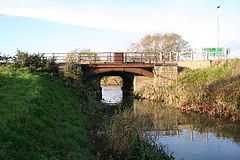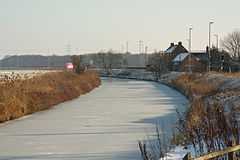Drinsey Nook
| Drinsey Nook | |
 Tom Otter's Bridge |
|
 The Foss Dyke, frosted over |
|
 Drinsey Nook |
|
| OS grid reference | SK870743 |
|---|---|
| – London | 153 mi (246 km) S |
| District | West Lindsey |
| Shire county | Lincolnshire |
| Region | East Midlands |
| Country | England |
| Sovereign state | United Kingdom |
| Post town | Lincoln |
| Postcode district | LN1 |
| Police | Lincolnshire |
| Fire | Lincolnshire |
| Ambulance | East Midlands |
| EU Parliament | East Midlands |
| UK Parliament | Gainsborough |
|
|
Coordinates: 53°15′33″N 0°41′47″W / 53.259189°N 0.696325°W
Drinsey Nook is a small village in the West Lindsey district of Lincolnshire, England. It is situated approximately 2 miles (3 km) south-west from Saxilby, close to the county border with Nottinghamshire. The village sits on the bank of the east of Lincoln section of the Foss Dyke, a canal which runs from the River Trent to the River Witham.
Drinsey Nook is notable for Tom Otter, a man who murdered his new wife in 1805. Otter, reputedly from Treswell, was already a married when he married his wife, Mary, whom he murdered the same day near the bridge that now bears his name. He was hanged in 1806, and was held in a Gibbet post adjacent to Gibbet Wood.[1][2] Tom Otter lane is the B1190 running south from the village, and Tom Otters Bridge is named after the site of the murder.[3][2]
References
- ↑ The handbook guide to lincoln and business intelligencer (3 ed.). R. E. Leary. 1855. p. 64. Retrieved 23 July 2011.
- ↑ 2.0 2.1 "Tom Otter - Fact or Fiction?". Saxilby and District History Group. 2013. Retrieved 2013-04-09.
- ↑ Pickering, W (1848). The Gentleman's Magazine (Vol 30 ed.). p. 296.
External links
 Media related to Drinsey Nook at Wikimedia Commons
Media related to Drinsey Nook at Wikimedia Commons- The Tale Of Tom Otter
| ||||||||||||||||||||||